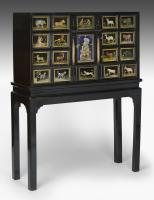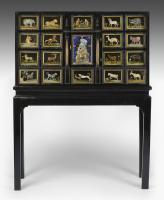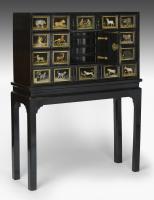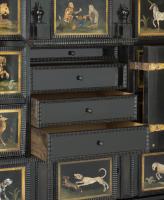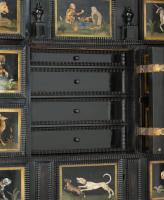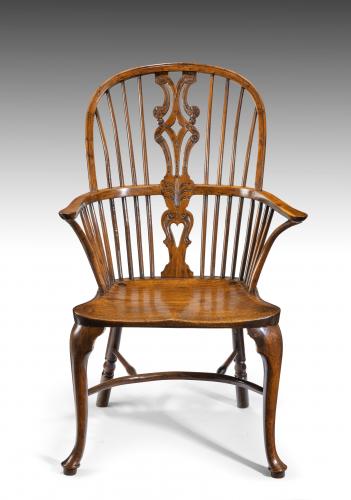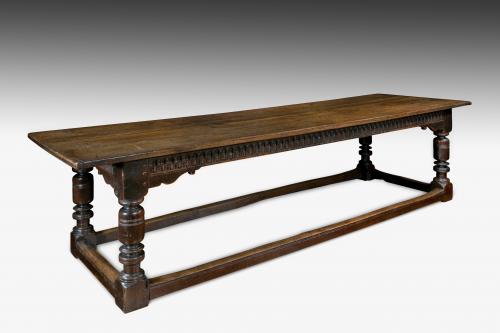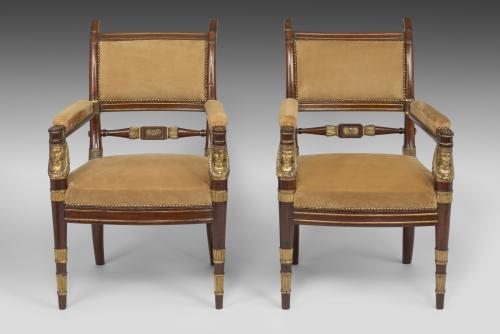
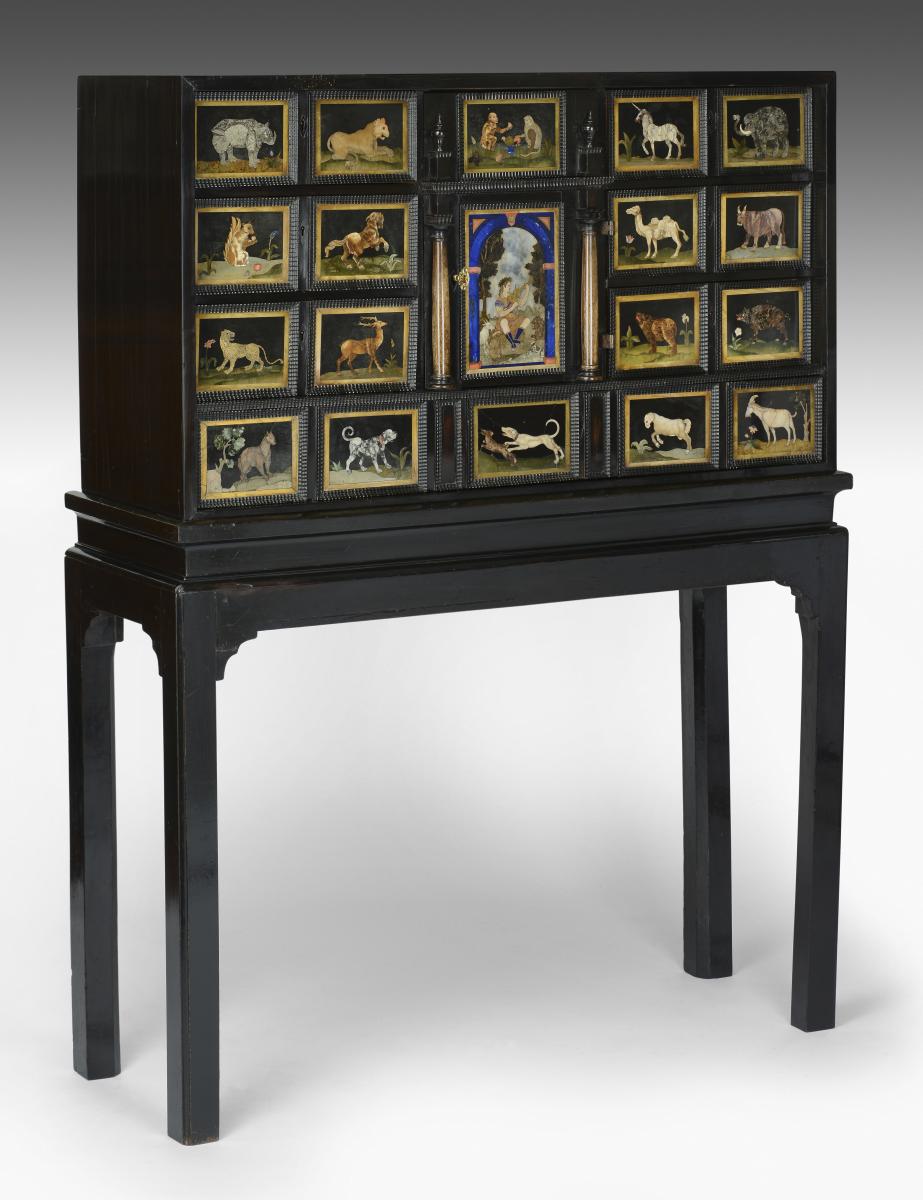
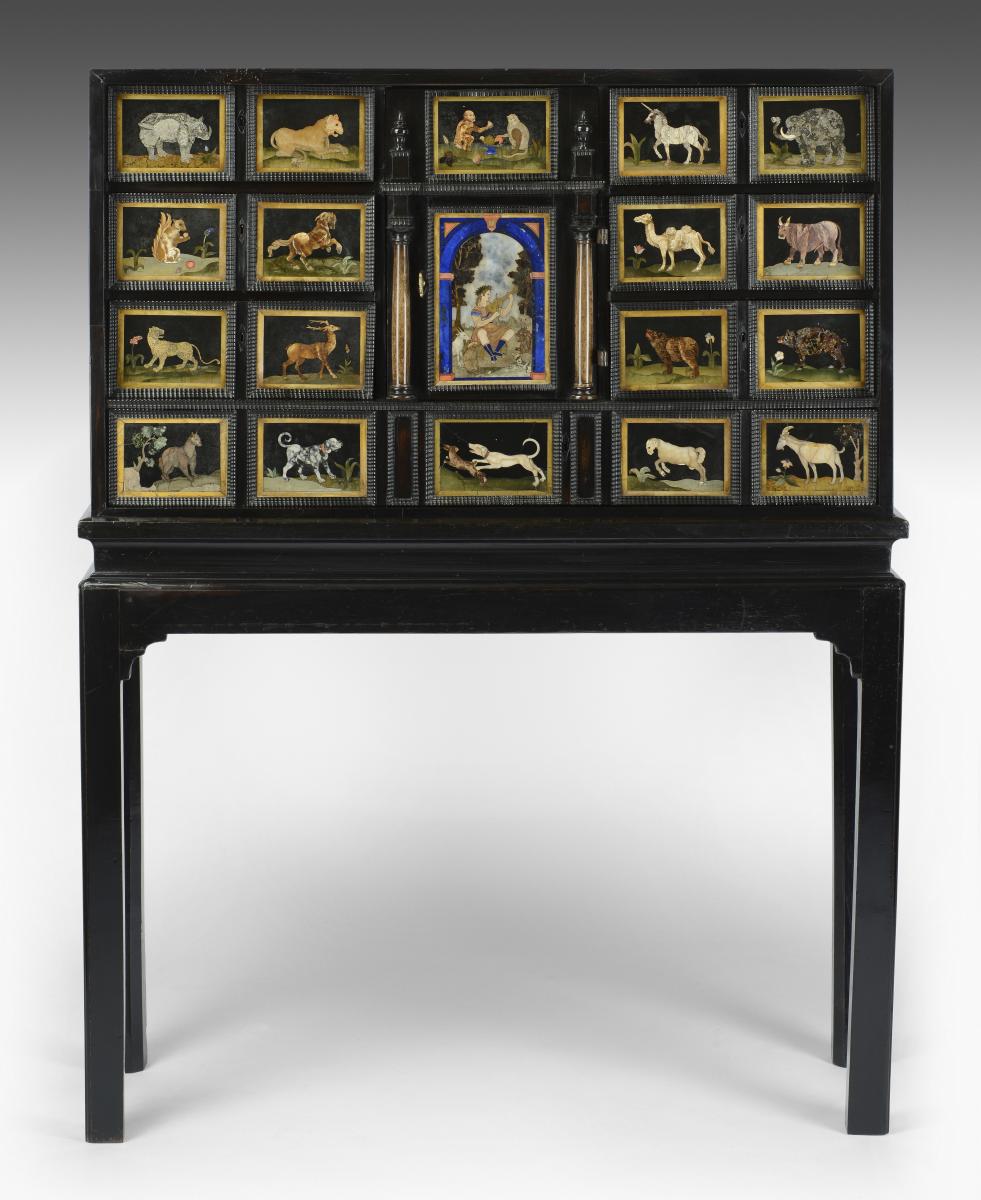
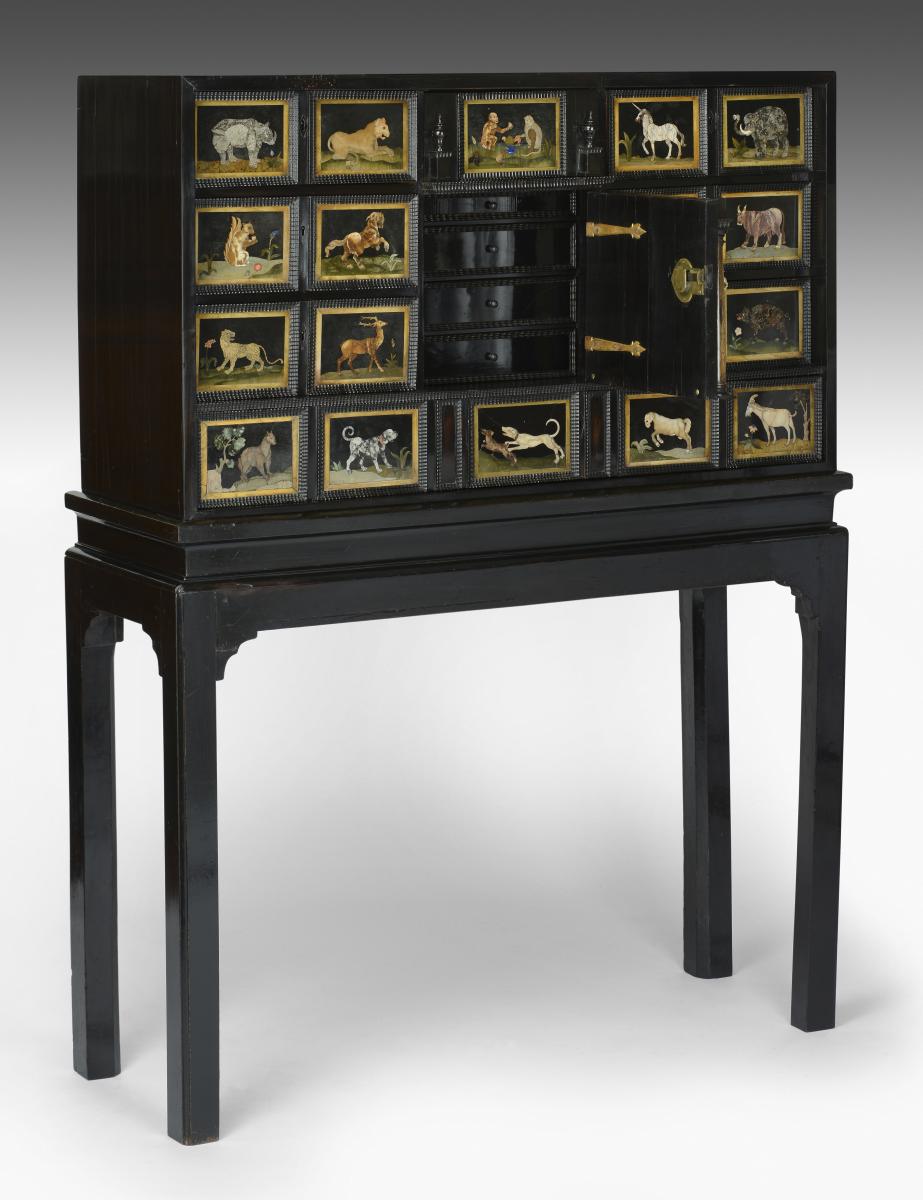
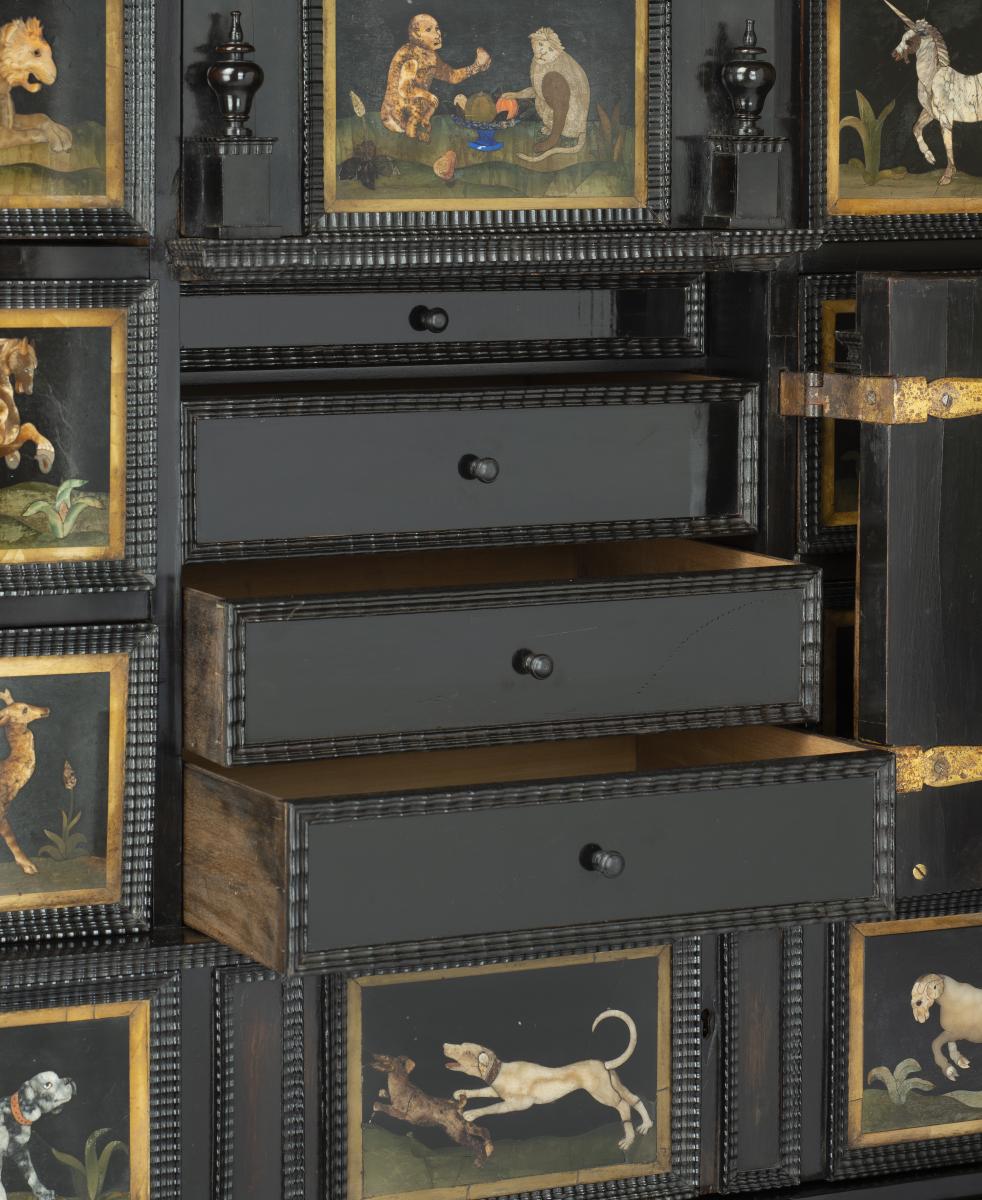
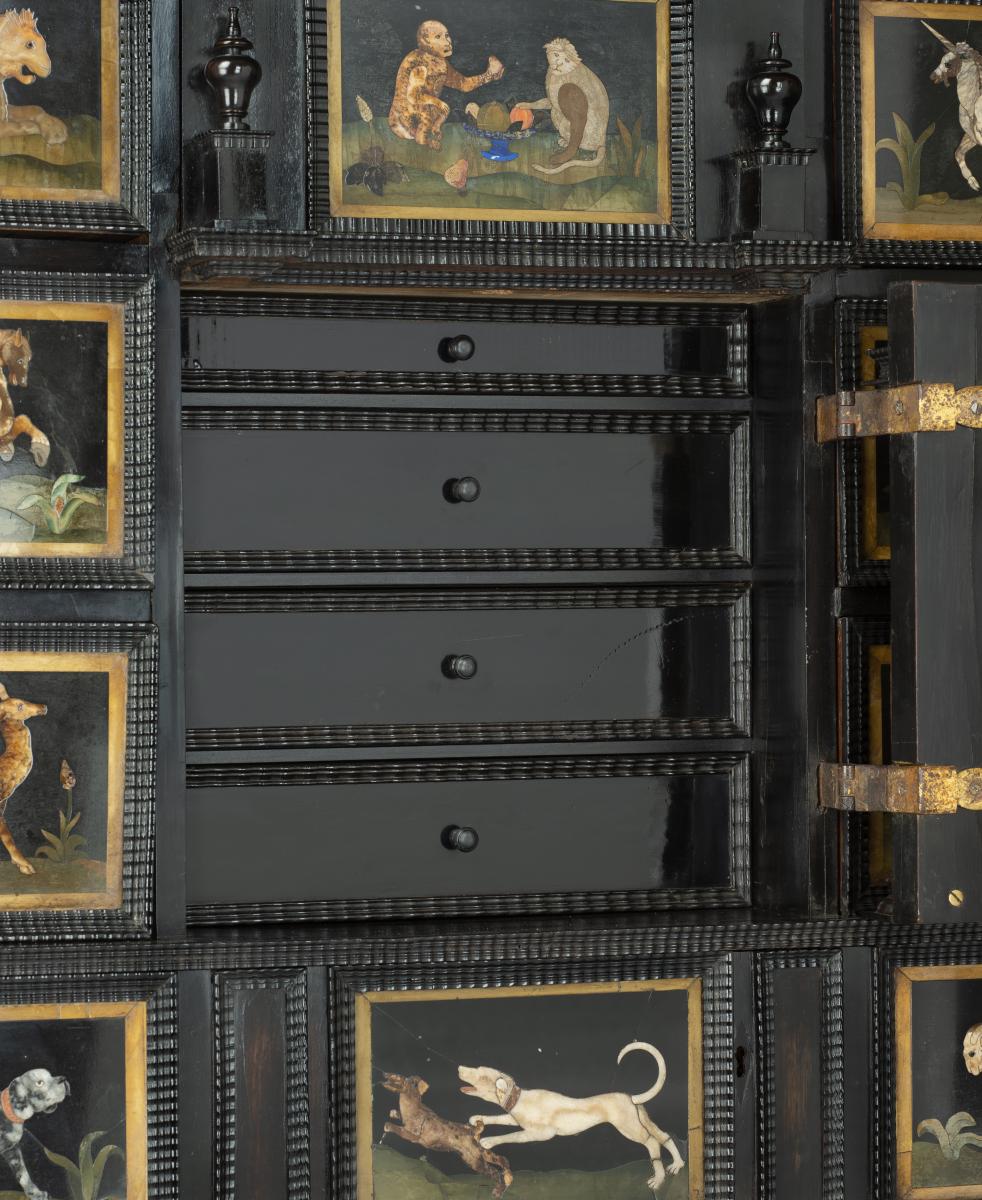
Price on application
This object includes complimentary, Insured Shipping / Delivery within the UK
This object is eligible for a Certificate of BADA Provenance
The BADA Standard
- Since 1918, BADA has been the leading association for the antiques and fine art trade
- Members are elected for their knowledge, integrity and quality of stock
- Our clients are protected by BADA’s code of conduct
- Our dealers’ membership is reviewed and renewed annually
- Bada.org is a non-profit site: clients deal directly with members and they pay no hidden fees
THE CABINET ITALY, CIRCA 1620,
THE STAND ENGLISH CIRCA 1750-1775
Provenance:
Anonymous sale; Phillips, London, 21 April 1998, lot 70
English Private Collection
With eight drawers around a central door inset with a lapis lazuli-bordered panel depicting Orpheus surrounded by the animals. The central panel flanked by alabastro fiorito columns and enclosing four re-instated, graduated ebony fronted drawers with ripple mouldings, of recent manufacture. The exterior ripple-moulded drawers inset with eighteen pietra dura panels depicting two monkeys eating from a fruit bowl, a hare and hound, a unicorn, a camel, a bull, an elephant, a bear, a wild boar, a ram and a goat, a leopard, a deer and a dog, a rhinoceros, a lion, a horse and a squirrel; the George III ebonized stand with square chamfered legs.
Orpheus charming the animals with his lira da braccio, an early type of viol is a popular subject throughout art and design, but the central panel of our cabinet bears a striking resemblance to that on the Barberini Cabinet in the Metropolitan Museum of Art compared to the current cabinet and another cabinet sold by Thomas Coulborn & Sons.
Interestingly the current cabinet shares a lapis lazuli arch over Orpheus with the cabinet made for the Frescobaldi family, now at the Detroit Institute of Arts.
The central panel depicts the legendary poet, Orpheus, the son of Oeagrus, King of Thrace, and the muse Calliope, who presided over epic poetry and music. According to Greek mythology, Orpheus received a lyre from Apollo and was taught to play the instrument by the Muses. His gift enabled him to charm all the animals, birds and reptiles, which are shown gathered around him, and to make the rocks and tress move and dance. The scene is based on an etching by Antonio Tempesta (1555–1630) entitled ‘Orpheus Charming the Birds and the Animals’ (Harvard Art Museums/Fogg Museum, object no. S9.26; http://www.harvardartmuseums.org/art/236391 and it became one of the Galleria de’ Lavori’s most popular subjects. This work reflects the high technical standards of the workshop (W. Koeppe, A. Giusti, Art of the Royal Court: Treasures in Pietre Dure from the Palaces of Europe, New Haven and London, 2008, pp. 176-177). The Galleria de' Lavori, the Medici grand-ducal workshop in Florence, was founded by Grand Duke Ferdinando I of Tuscany in 1588.
There are at least twenty two documented pieces of furniture which reflect the high technical standards of the workshop, each with a slightly varied central Orpheus plaque and different animal panels (Annamaria Giusti and Wolfram Koeppe (Eds.), ‘Art of the Royal Court: Treasures in Pietre Dure from the Palaces of Europe’, New Haven and London, 2008, pp. 176-177).
The documented hardstone plaques which depict Orpheus include an ebony and pietre dure table cabinet, dated circa 1620, formerly in the collection of the Frescobaldi family of Florence, which is now in the collection of the Detroit Institute of Arts (https://www.dia.org/art/collection/object/pietre-dure-cabinet-25433). Interestingly it includes a similarly rare assortment of other animals surrounding the central panel.
‘The Cucci Cabinet’, designed by 17th Century Italian furniture master Domenico Cucci, also has a central panel depicting Orpheus playing his lyre, and similar surrounding panels of exotic animals. The cabinet was almost certainly acquired by Queen Hedvig Eleonora (1636-1715), who was married to King Charles X of Sweden (1622-1660). The cabinet is dated before circa 1665-1670.
‘Pietra dura’ or ‘pietre dure’ is an inlay technique using cut and fitted, highly-polished colored stones to create images. The stones are sliced and cut in different shape sections. The stonework, after the work is assembled loosely, is glued stone-by-stone to a substrate. It is assembled precisely so that the contact between each section is practically invisible. Grand pieces of furniture such as this were used as ‘cabinets of curiosities’, as statement pieces in rooms and as statements of wealth. The pietra dura pictorial panels were created by the Galleria de' Lavori, the Medici grand-ducal workshop in Florence. Whoever commissioned the cabinet probably collected the specimens on their Grand Tour. The 'Grand Tour' was an essential aspect of the education of young noblemen during the 18th Century and early 19th Century. Their premier destination was Italy where they would immerse themselves in the history, politics, culture and art of the country whose ancient and Renaissance art awaited their discovery and purchase.
The most famous tale of Orpheus surrounds the death of his beloved Eurydice. When Orpheus’ wife Eurydice fell into a nest of vipers and died, he mourned her death by playing music. In Ovid’s Metamorphoses he recounts how the harsh Fates shed their first tears listening to Orpheus’ transcendent music. They advised him to meet with the gods of the Underworld, Hades and Persephone, to try and rescue his wife. So moved by his plea and his beautiful music the gods agreed but told him he must not look back until they reach the surface. Eager to see his wife again, just before the opening of the cave Orpheus looked back, thus sending her back to the Underworld forever. He spent the rest of his life mourning his wife, never to love again, and enchanting those with his sorrowful music. One day, Orpheus sent to worship the sun god Apollo, and was caught by Maenads for not properly honoring the oracle Dionysus and was killed.
This tale became an increasingly popular depiction in sixteenth-century art. During a period of intense political upheaval and religious strife, the story became a symbol of hope and endurance.
One of the most important examples is the Barberini Cabinet in the Metropolitan Museum of Art, completed between 1606-1623. The central panel similarly modelled with Orpheus on a rock, playing music amongst the animals is surrounded by whimsical illustrations of animals and the hunt, after woodcut illustrations from Aesop’s Fables.
The impressive jewel-like panels most popularly illustrated birds, flowers and animals, even visitors in exotic textiles and Italianate landscapes. In the latter half of the seventeenth century many wealthy patrons embarking on the ‘Grand Tour’ collected these panels, and often commissioned cabinets to set the panels into, such as the present lot. The design evolved from the German Wunderkammer or Italian studiolo, with ebony-framed reliquaries ornamented with pietra dura panels and gilt mounts. They had several functions: as a ‘cabinet of curiosities’ in which precious items such as gemstones, carved ivories and small bronzes were kept; as a statement piece of furniture that illustrated the refined learning of the cabinet’s owner; and also to display wealth and prestige. Occasionally, sets of pietra dura panels of Orpheus together with smaller ones of animals having come to listen to him were sold together. Only three other cabinets are known to incorporate full surviving sets: an Italian table cabinet dated to circa 1620 and now at the Detroit Institute of Arts (inv. 1994.77 and illustrated A. Giusti, Pietre Dure and the Art of the Florentine Inlay, London, 2006, pp. 168-9, ill. 138); a Flemish cabinet-on-stand sold from the collections of Valerian Rybar and Jean-François Daigre, Christie's, Paris, 5 June 2003, lot 35; and an exquisite French cabinet attributed to Domenico Cucci and the Gobelins Workshop, dated to circa 1665-1675 and sold at Christie’s, London, 10 December 2009, lot 875.
Dimensions
141 x 109 x 38 cmPrice on application
This object includes complimentary, Insured Shipping / Delivery within the UK
This object is eligible for a Certificate of BADA Provenance
Stock number
6844The BADA Standard
- Since 1918, BADA has been the leading association for the antiques and fine art trade
- Members are elected for their knowledge, integrity and quality of stock
- Our clients are protected by BADA’s code of conduct
- Our dealers’ membership is reviewed and renewed annually
- Bada.org is a non-profit site: clients deal directly with members and they pay no hidden fees


